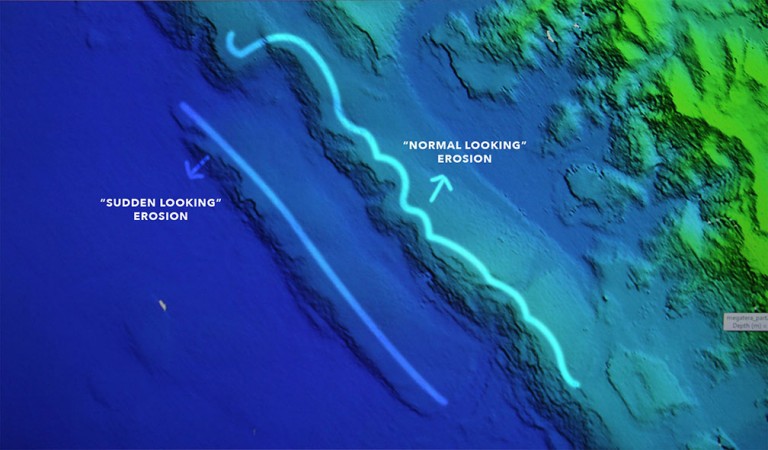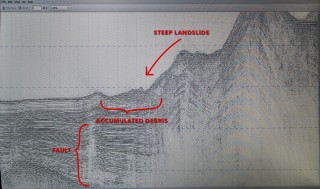Prior to R/V Falkor’s departure from Singapore towards the Wharton Basin and the Mentawai islands, much was discussed about what could be found under the waters of the Indian Ocean. But Dr. Satish Singh was more interested in the unknown, and less intrigued by what they knew could be found. “That is how science is done, and how discoveries are made,” he said.


Sure enough, as data traveled from the depths of the ocean to the screens on the Science Control Room, surprises started to emerge. This is the most seismically active region on our planet, and still the scientific team did not expect to find the kind of mass wasting that they have witnessed.
Mass wasting
In order to understand what mass wasting is, you may think of landslides. Geological structures are continuously fighting against gravity. But no matter how strong the mountain is, gravitational pull is constant, so when something changes the mountain’s ability to resist it, some material will precipitate to lower heights. Mass wasting is a natural process that occurs in both mountains and seamounts – that is, it happens on underwater mountains as well.

The role of earthquakes
Mass wasting can be accelerated by external factors, such as earthquakes. The violent shaking during an earthquake has the potential to break off sections of mountains or hills, causing them to slide down the slope. What remains is a geological structure with some evident erosion on its sides and debris at the bottom of it. The mountain will no longer rest at its angle of repose, it will be much steeper and vulnerable.
The surprise
So if the scientists onboard of R/V Falkor already expected to find seamounts under these waters, and they knew that this area is under constant seismic pressure, what was the surprise?
The amount of mass wasting is astonishing. “We need time to process the data and understand if these are old geological structures,” said Dr. Singh, “but they look fresh to me. What this could mean is that these mountains are deteriorating at a higher pace than the natural erosion process.”
Combined bathymetry and seismic reflection data will not be enough to determine the age of these seamounts. But the observations open the door for interesting scientific discussions. In the future, measuring the pressure on the slope’s sediments and taking samples from the seafloor will help determine the precise age of the structures.
If the scientists find that the structures are old, then they might conclude that earthquakes are not to blame for the amount of mass wasting observed. But the images in the Science Control Room’s screens depicting seamounts that present “normal” erosion shapes sitting next to steep inclinations that look as if they had been cut with a knife seem to suggest that a lot of these landslides are the product of strong shaking all the way to the subduction front itself.
“This is beautiful,” says Dr. Singh. “Even if we cannot conclude anything just yet, these are very interesting observations.”

